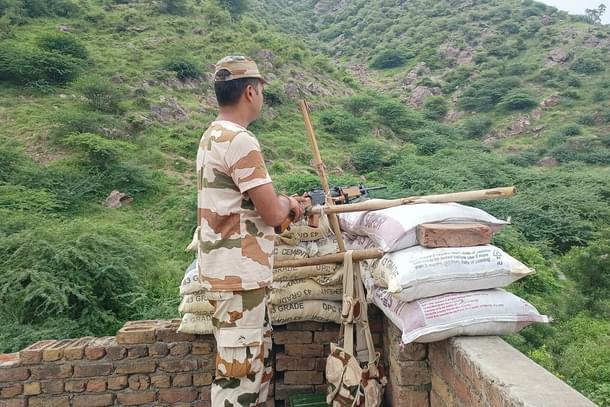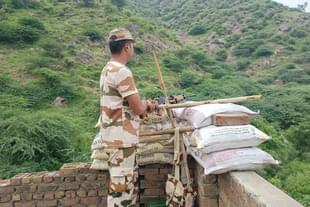Ground Reports
Ground Report: A Week After Nuh Violence, Temple Resembles Military Base, Rooftop Bunkers Installed, 'YouTubers' Barred
Swati Goel Sharma
Aug 09, 2023, 08:37 AM | Updated Aug 29, 2023, 11:40 PM IST
Save & read from anywhere!
Bookmark stories for easy access on any device or the Swarajya app.


Driving from New Delhi to Haryana’s Nuh district, it was evident that the route is under heightened security.
As we approached Sohna, roughly 30 kilometre from Nuh’s Nalhar Mahadev temple, police were noticeably stationed at various points.
The temple was the site of a recent attack on 31 July, during a gathering for jalabhishek — a significant event before pilgrims commence their visits to various ancient temples.
Nuh holds the distinction of being Haryana’s sole Muslim-majority district, with approximately 90 per cent of its population practicing Islam. Beyond its demographic makeup, it’s also known for its illegal beef trade and cybercrimes including sextortions and financial frauds. Niti Aayog in 2018 called it the most backward district in the country.
Until 2016, Nuh was called Mewat in government documents, the term derived from the dominant Meo jaati inhabiting the area. Meos, who have been almost wholly Islamised over the last 800 years, have significant population in the adjoining Alwar and Bharatpur districts of Rajasthan as well.
Approaching the town's main intersection, Nuh chowk, the robust presence of security forces was hard to miss.
Venturing further into Nuh, about 400 metre ahead, there was evidence of recent disturbances: JCB machines tearing down structures, with mostly women present, likely because the men, fearing potential repercussions for their involvement in the recent turmoil, had fled.



Connectivity became a challenge as we moved deeper into the district, with our internet signal dissipating.
The landscape also transformed; the dense housing near Nuh chowk began to spread out, giving way to the more remote Nalhar Shiv temple. Evidence of recent violence, in the form of charred cars and burnt trees, lined the roads leading up to the temple.
The temple, set against the backdrop of hills on three sides, had become the site of an ambush, with assailants believed to have used the hill's steep terrains for their vantage.
The temple is nestled within a predominantly Muslim residential area, but maintains its own insular community with about ten Hindu households in its immediate vicinity.
Entering the temple complex was no simple affair; stringent security measures were in place. We were questioned and vetted by the guards before being granted access. "YouTubers" were not welcome, the guards told us plainly.
When we introduced ourselves as correspondents for a magazine, they agreed to see our identity cards and eventually let us in.

Inside, the temple, which is usually a place of spiritual calm, had transformed into a fortress with massive security deployment. Camps had been set up at several points, making the site resemble a conflict zone.
Against 500 security personnel, only ten members of the temple staff were present, a policeman told us. The head priest greeted us with folded hands and immediately left. A helper said it was time for his rest. It was obvious that the pujari did not wish to talk to the media anymore.
The helper said, "You are visiting today but might forget the temple by tomorrow. However, Panditji and we must stay and serve here. Who will protect us when everyone else is gone?"




We climbed to the terrace, where at each corner, soldiers were stationed behind temporary bunkers. Their weapons were trained on the surrounding hills.
The guards asked us to leave. When we requested for a picture, one of them agreed, but on the promise that the face wouldn't show.

We eventually found three people standing in a group outside the temple, who were civilians and not temple staff, and agreed to talk.
Ramkishen Bhagat is a resident of Chhapera village, which is about 10 kilometre away from Nuh. He described the horrifying turn of events on the day of the attack as a "sudden onslaught from the hills."
He said, "I was at the Nalhar temple when the violence erupted. Between 11am and noon, there were at least 3,000 people present, including numerous women and children. We were planning to visit a temple in Firozepur Jhirka and then head to the Singar village temple. But just as we were preparing to leave, stones began to rain down from the hills," he said.
Before the devotees could even process what was happening, they heard gunshots. Panic took over, and everyone began to scatter in every direction, he said.

As per police, two home guards died in the attack. Two participants of the yatra, Pradeep Chauhan and Abhishek Saini, sustained severe injuries and succumbed later.
The attack was preceded by threats issued over social media from Meo residents of Nuh, directed at Bajrang Dal and particularly against the organisation’s Gau Raksha Dal head, Monu Manesar.
Swarajya reported about the threats and the controversy around Manesar here and here. Police have also accessed an audio clip, where a man introducing himself as “Mewati” (the term is synonymous with Muslim Meo residents of the Mewat region) is calling upon fellow Mewatis to gather at the temple in Singar and killed “at least 10-20 people”.
News reports have quoted police officers as saying that the planning of the attack was done over ten days where Whatsapp groups were formed, people delegated roles, stones and glass bottles were collected, and number plates of motorcycles were blackened to escape identification later on.
Ramkishen accused the MLA of Firozepur Jhirka, Mamman Khan, of being privy to information about a possible attack. “It’s not easy for a thousand people to gather on the hills without anybody knowing,” he said. "Mamman Khan knew about this," he added.
Others we spoke to shared this sentiment. Anand Sharma, identifying himself as a worker for the Vishva Hindu Parishad (VHP), said it was impossible that the attack was spontaneous. "It takes hours to trek to the hilltops," he reasoned.

Meanwhile, Sachin Yadav, a regular participant in the yatra, expressed his sorrow and disbelief over the violent events.
He said the area has a longstanding tradition of interfaith harmony and recalled how, just a few days earlier, Hindu residents had extended goodwill to Muharram observers and served them sharbat.

The temple, typically bustling with the sounds of visitors and aartis, had taken on an entirely different atmosphere on Saturday (5 August), bearing more resemblance to a fortified military outpost than a place of worship.
(Note: The visit was made by Prabhat Kumar and Mayur Bhosale. The report has been written by Swati Goel Sharma based on their inputs).
Swati Goel Sharma is a senior editor at Swarajya. She tweets at @swati_gs.





